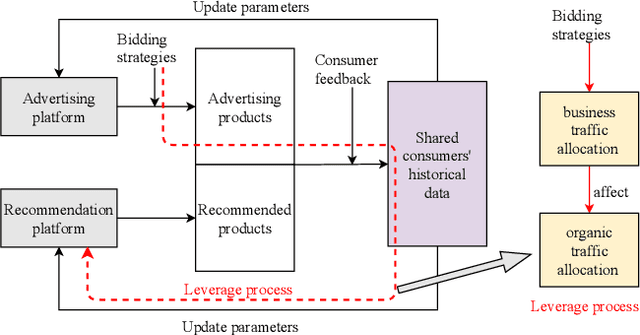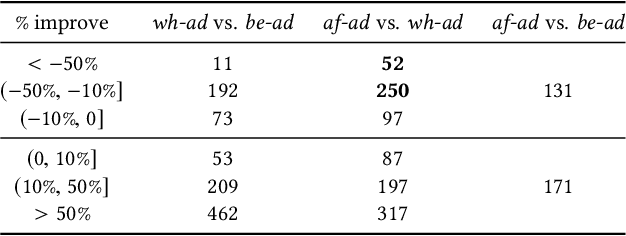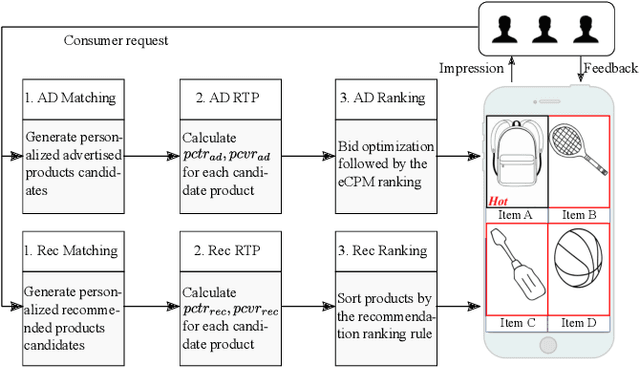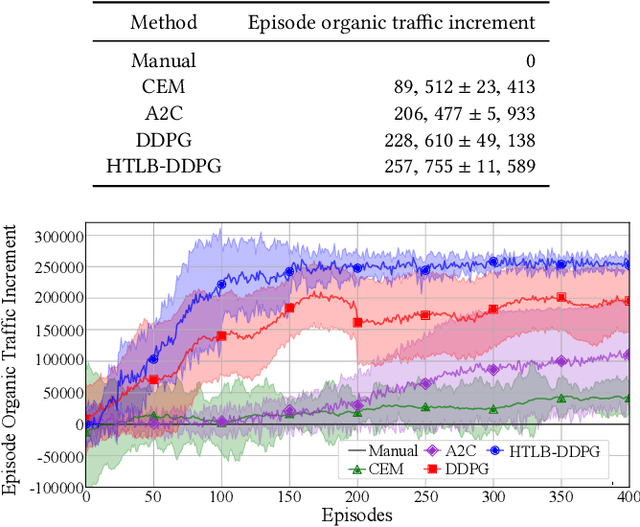Dagui Chen
Hierarchically Constrained Adaptive Ad Exposure in Feeds
May 31, 2022



Abstract:A contemporary feed application usually provides blended results of organic items and sponsored items~(ads) to users. Conventionally, ads are exposed at fixed positions. Such a static exposure strategy is inefficient due to ignoring users' personalized preferences towards ads. To this end, adaptive ad exposure has become an appealing strategy to boost the overall performance of the feed. However, existing approaches to implementing the adaptive ad exposure still suffer from several limitations: 1) they usually fall into sub-optimal solutions because of only focusing on request-level optimization without consideration of the long-term application-level performance and constraints, 2) they neglect the necessity of keeping the game-theoretical properties of ad auctions, which may lead to anarchy in bidding, and 3) they can hardly be deployed in large-scale applications due to high computational complexity. In this paper, we focus on long-term performance optimization under hierarchical constraints in feeds and formulate the adaptive ad exposure as a Dynamic Knapsack Problem. We propose an effective approach: Hierarchically Constrained Adaptive Ad Exposure~(HCA2E). We present that HCA2E possesses desired game-theoretical properties, computational efficiency, and performance robustness. Comprehensive offline and online experiments on a leading e-commerce application demonstrate the significant performance superiority of HCA2E over representative baselines. HCA2E has also been deployed on this application to serve millions of daily users.
Neural Auction: End-to-End Learning of Auction Mechanisms for E-Commerce Advertising
Jun 07, 2021Abstract:In e-commerce advertising, it is crucial to jointly consider various performance metrics, e.g., user experience, advertiser utility, and platform revenue. Traditional auction mechanisms, such as GSP and VCG auctions, can be suboptimal due to their fixed allocation rules to optimize a single performance metric (e.g., revenue or social welfare). Recently, data-driven auctions, learned directly from auction outcomes to optimize multiple performance metrics, have attracted increasing research interests. However, the procedure of auction mechanisms involves various discrete calculation operations, making it challenging to be compatible with continuous optimization pipelines in machine learning. In this paper, we design \underline{D}eep \underline{N}eural \underline{A}uctions (DNAs) to enable end-to-end auction learning by proposing a differentiable model to relax the discrete sorting operation, a key component in auctions. We optimize the performance metrics by developing deep models to efficiently extract contexts from auctions, providing rich features for auction design. We further integrate the game theoretical conditions within the model design, to guarantee the stability of the auctions. DNAs have been successfully deployed in the e-commerce advertising system at Taobao. Experimental evaluation results on both large-scale data set as well as online A/B test demonstrated that DNAs significantly outperformed other mechanisms widely adopted in industry.
Learning to Advertise for Organic Traffic Maximization in E-Commerce Product Feeds
Aug 19, 2019



Abstract:Most e-commerce product feeds provide blended results of advertised products and recommended products to consumers. The underlying advertising and recommendation platforms share similar if not exactly the same set of candidate products. Consumers' behaviors on the advertised results constitute part of the recommendation model's training data and therefore can influence the recommended results. We refer to this process as Leverage. Considering this mechanism, we propose a novel perspective that advertisers can strategically bid through the advertising platform to optimize their recommended organic traffic. By analyzing the real-world data, we first explain the principles of Leverage mechanism, i.e., the dynamic models of Leverage. Then we introduce a novel Leverage optimization problem and formulate it with a Markov Decision Process. To deal with the sample complexity challenge in model-free reinforcement learning, we propose a novel Hybrid Training Leverage Bidding (HTLB) algorithm which combines the real-world samples and the emulator-generated samples to boost the learning speed and stability. Our offline experiments as well as the results from the online deployment demonstrate the superior performance of our approach.
FOTS: Fast Oriented Text Spotting with a Unified Network
Jan 15, 2018



Abstract:Incidental scene text spotting is considered one of the most difficult and valuable challenges in the document analysis community. Most existing methods treat text detection and recognition as separate tasks. In this work, we propose a unified end-to-end trainable Fast Oriented Text Spotting (FOTS) network for simultaneous detection and recognition, sharing computation and visual information among the two complementary tasks. Specially, RoIRotate is introduced to share convolutional features between detection and recognition. Benefiting from convolution sharing strategy, our FOTS has little computation overhead compared to baseline text detection network, and the joint training method learns more generic features to make our method perform better than these two-stage methods. Experiments on ICDAR 2015, ICDAR 2017 MLT, and ICDAR 2013 datasets demonstrate that the proposed method outperforms state-of-the-art methods significantly, which further allows us to develop the first real-time oriented text spotting system which surpasses all previous state-of-the-art results by more than 5% on ICDAR 2015 text spotting task while keeping 22.6 fps.
 Add to Chrome
Add to Chrome Add to Firefox
Add to Firefox Add to Edge
Add to Edge